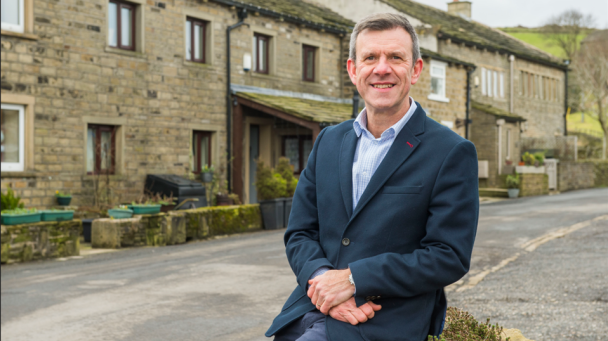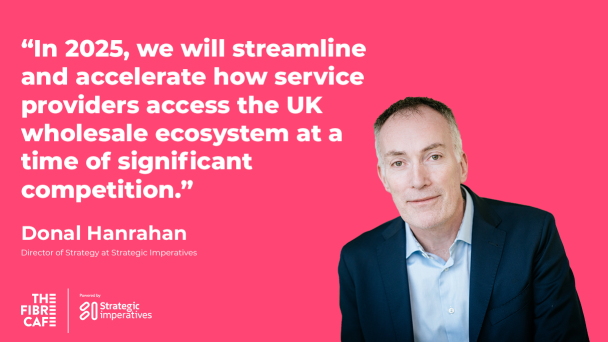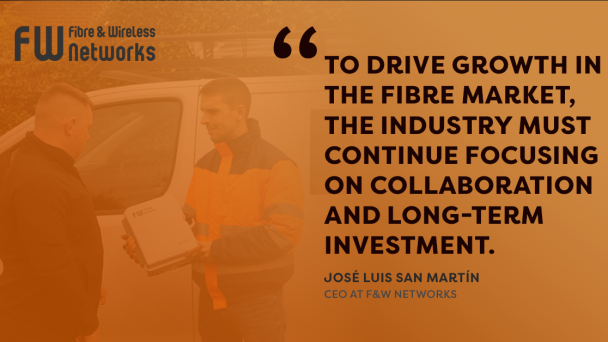Access is critical to empowering service provider success, according to Donal Hanrahan, Director of Strategy at Strategic Imperatives. Here he discusses his plans and priorities to ensure The Fibre Café, its cloud based, API-driven integration platform, continues to catalyse competition and drive positive outcomes.

Quickline CEO Sean Royce forecasts the collapse of rural communities as the UK’s fibre coverage targets make hard-to-reach areas an unattractive prospect. Fibre providers continue to be put off by the cost and complexity of taking their rollouts to sparse geographies, instead opting to overbuild others in cities and market towns.
He is urging providers to instead champion deeply rural communities and blend fibre with other technologies, even if they fall short of the Gigabit mark. “Fibre has become the nation’s gold standard for connectivity,” he says. “But it is never going to be the solution to 100% of the premises in the UK.”
“If the option is fibre or nothing, then the areas where fibre is untenable will ultimately be the big losers. The irony is, that the deadline will keep being pushed to the right if these rural communities never get addressed.”
He highlights that these are the areas most in need of speed upgrades, with residents being unable to use the services that were digitised during the pandemic.
“I have started looking at these beautiful countryside towns and villages through a broadband lens and thinking, how are these guys surviving in the digital age?,” he says. “In these areas it is much harder to walk to a GP or a chemist and people are struggling to socialise, work, do their shopping, or their banking, let alone access the increasingly digitised public services.
“If upgrades are not afforded to these residents, then they will simply leave, and we will see the death of many rural communities across the UK.”
To boost speeds, Quickline operates a hybrid method, using a patchwork of technology to ensure all premises receive an upgrade, gigabit or not. The altnet blends next generation wireless technology to get across special engineering difficulties, providing Gigabit wireless solutions to the home and blending this with fibre where it makes sense and becomes more economical.
The model enables engineers to build the network according to the terrain. “This allows us to act in areas where a cookie cutter fibre approach simply wouldn't work.”
The altnet is currently operating throughout Yorkshire and Lincolnshire, passing 300,000 premises in deeply rural areas with a wireless Gigabit-capable solution and another 10,000 with full fibre. This comes from a standing start nine months ago and is buoyed by investment from Northleaf Capital Partners. This week Quickline have also announced that their fibre build will pass an additional 55,000 premises in 2023, across another 100 rural communities.
“Our rollout continues apace, but we will not be able to address every hard-to-reach area in the UK and the places that don’t get broadband are at risk.”
Royce shares that this was his raison d’etre for joining Quickline, having previously held a key role in KCOM’s FTTP project as MD of the East Yorkshire business. “The benefits for rural residents are incredibly tangible,” he said. “People see us as heroes as they have long been neglected by other operators, who are put off by the cost and complexity of getting fibre to sparse geographies.
The company's aim is to address a total of 500,000 rural premises in the coming years by expanding its next-generation hybrid network and participating in BDUK’s Project Gigabit programme – which Royce confesses is not as straightforward as it perhaps should be.
“Our objective for 2023 is to accelerate our build significantly and address the pent-up demand we are seeing as we step through small towns and villages,” said Royce.
The lack of progress being made in rural areas is a key reason that the UK’s targets are being constantly pushed to the right, with last year’s Levelling Up Whitepaper altering the 85% coverage deadline from 2025 to 2030.
“The cities are full of the big operators and now everyone is fighting over space in the market towns because the meterage is lower than rural areas.”
The Market Town Goldrush
An article from Intelligens Consulting this week identifies that the UK’s top 10 alternative operators, VMO2 and Openreach, are on track to reach at least 78 million homes with fibre by 2026. When discussing this with Royce, he points out that the UK has less than 30 million dwellings in total.
This talks to an unsustainable level of overbuild that will likely come to a head in the coming year. “Lots of altnets are piling into an area where they think they can build it at the lowest cost,” said Royce. “They are going to get very low take ups between them because you can’t share pieces of the pie. It looks as though we are going to end up with a bloodbath of operators, particularly in market towns.”
Looking at the recent news from Fern Trading, it is clear that mass consolidation is imminent, remaining a sword of Damocles over many altnet’s investment cases.
Royce identifies this as another benefit of addressing the areas untouched by others. “We are confident about converting homes passed into homes connected and have great relationships with our customers as we have become their broadband champions,” he said.




